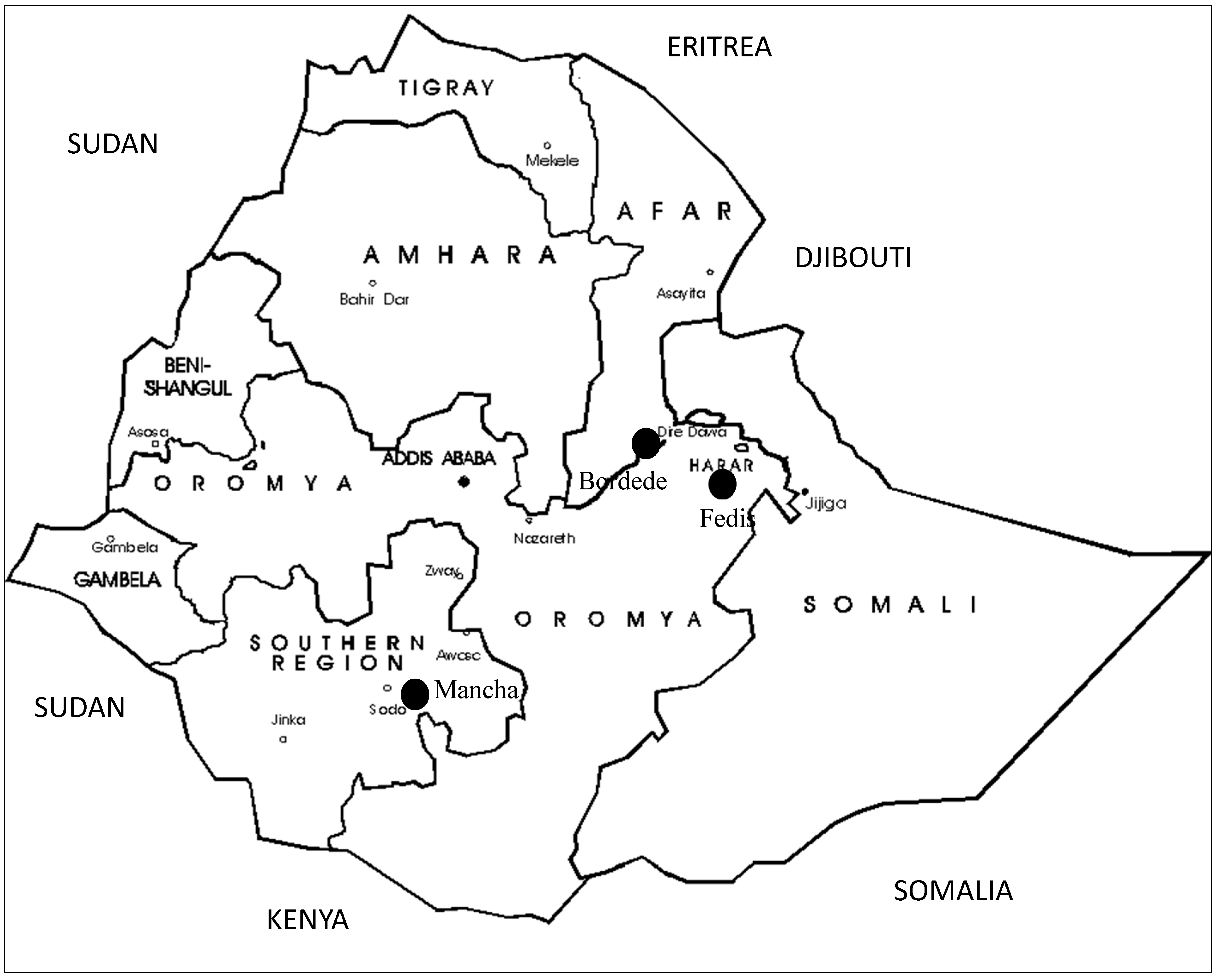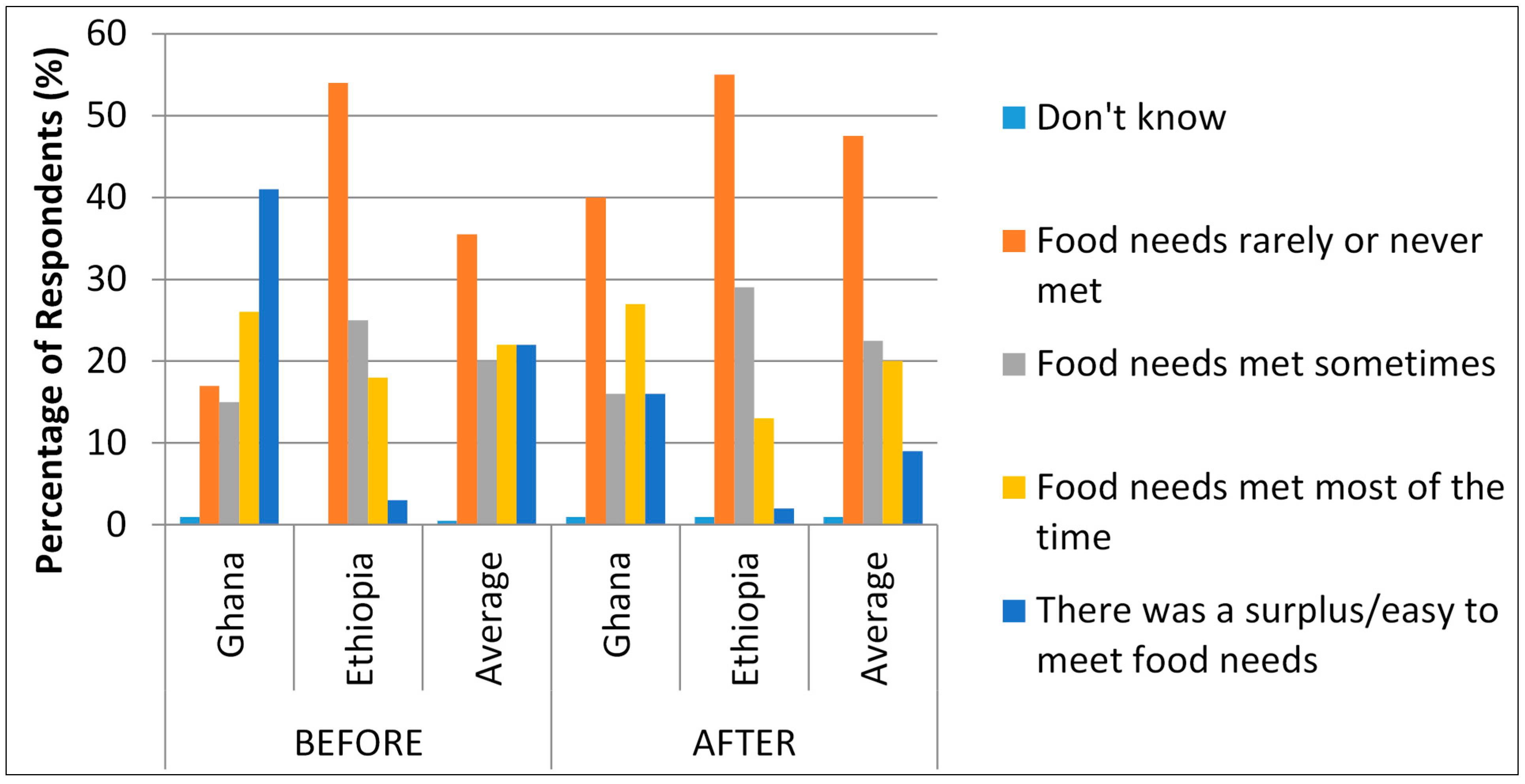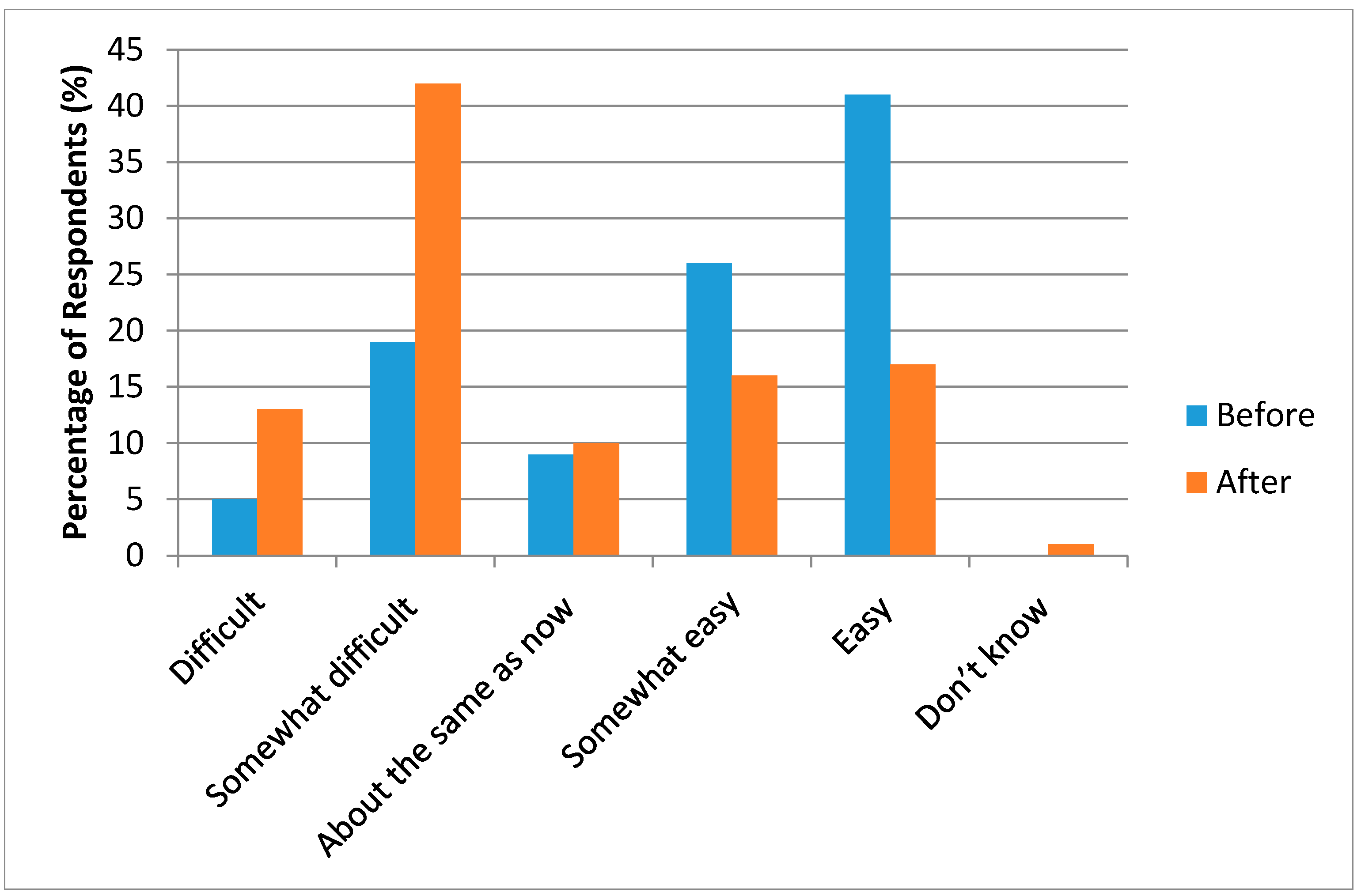Local Perceptions about the Effects of Jatropha (Jatropha curcas) and Castor (Ricinus communis) Plantations on Households in Ghana and Ethiopia
Abstract
:1. Introduction
1.1. Assessing the Effects of Industrial Biofuel Plantations in Africa: Jatropha (Jatropha curcas) and Castor (Ricinus communis L)
1.2. Study Rationale
2. Methods
2.1. Description and Selection of Study Sites
| Study Site Name | Number of Household Questionnaires Administered | Number of Expert Interviews/Focus Group Discussions (FGDs) | Type of Biofuel Feedstock | Biofuel Company |
|---|---|---|---|---|
| Ghana | ||||
| Adidome | 12 | 2/11 | Jatropha | Galton Agro Ltd. |
| Agogo | 30 | 4/7 | Jatropha | ScanFarm (formally ScanFuel) |
| Ahenekom | 5 | 2/8 | Jatropha | Savannah Black Farming and Farm Mgt Ltd |
| Bredie Camp | - | 4/11 | Jatropha | Kimminic Corporation |
| Diare | - | 2/0 | Jatropha | Integrated Tamale Fruit Company (ITFC) |
| Kadelso | 52 | 4/0 | Jatropha | Jatropha Africa |
| Kobre | 50 | 3/9 | Jatropha | Kimminic Corporation |
| Kpachaa | 50 | 1/0 | Jatropha | Biofuel Africa |
| Kusawgu | - | 2/0 | Jatropha | Biofuel Africa |
| Lolito | 35 | 2/13 | Jatropha | Biofuel Africa |
| Old Akrade | - | 1/5 | Jatropha | Annuamom Industries |
| Ethiopia | ||||
| Bordede | 52 | 5/3 | Jatropha | Imami/New-Age Bio-Tech |
| Fedis | 50 | 7/3 | Castor bean | Flora Eco-Power |
| Mancha | 63 | 6/3 | Jatropha; Castor bean | Sun Biofuel; Global Energy |


2.2. Data Collection and Analysis
3. Results
3.1. Negative Effects of Biofuel Projects on Local Landholdings and Land Use Are Minimized
| Size of Land Lost (Acres) | Number of Respondents | Percent of Respondents |
|---|---|---|
| 0–10 | 76 | 69.7 |
| 11–20 | 8 | 7.3 |
| 21–30 | 4 | 3.7 |
| 31–40 | 3 | 2.8 |
| 41–50 | 3 | 2.8 |
| 51–60 | 1 | 0.9 |
| 61–70 | 2 | 1.8 |
| 71–80 | 2 | 1.8 |
| 81–90 | 1 | 0.9 |
| 91–100 | 1 | 0.9 |
| >100 | 8 | 7.3 |
| Total | 109 | 99.9 |
3.2. Household- and Community-Level Socio-Economic Effects Are Addressed
3.2.1. Local- and Community-Level Benefits from Biofuel Plantations
| Benefit | Ghana | Ethiopia | ||
|---|---|---|---|---|
| Yes | No | Yes | No | |
| Plantation created employment | 155 | 79 | 53 | 19 |
| The company built schools | 2 | 232 | 1 | 71 |
| The company built medical clinics | 11 | 223 | - | - |
| The company provided water wells or boreholes | 34 | 200 | 16 | 56 |
| The company provided/maintained local roads | 1 | 233 | 2 | 70 |
3.2.2. Changes in Household Economic Status

3.2.3. Local Food Security is Enhanced

3.2.4. Changes in Fallow Periods in Ghana

3.2.5. Changes in Fodder Availability in Ethiopia

4. Discussion
- comprehensive land inventories, and the development of sound guidelines and explicit standards for land allocations and sustainable land use, would appropriately identify potential areas for biofuel development;
- instituting and operationalising a biofuel policy to guide the acquisition of land for large-scale biofuel plantations would help to protect the vulnerable and the poor from land alienation; and
- clear and mandatory consultation procedures to ensure that customary land users have an inalienable voice in land negotiations.
Acknowledgments
Author Contributions
Conflicts of Interest
References and Notes
- Sulle, E.; Nelson, F. Biofuels, Land Access and Rural Livelihoods in Tanzania; IIED: London, UK, 2009. [Google Scholar]
- Molony, T.; Smith, J. Biofuels, Food Security and Africa. Afr. Aff. 2010, 109, 489–498. [Google Scholar] [CrossRef]
- Bassey, N. Agrofuels: The corporate plunder of Africa. Third World Resur. 2009, 223, 21–26. [Google Scholar]
- Bassey, N. The Agrofuels Debate in Africa: Challenges and Opportunities. In Proceedings of the Ecological Agriculture: Mitigating Climate Change, Providing Food Security and Self-Reliance for Rural Livelihoods in Africa Conference, Addis Ababa, Ethiopia, 26–28 November 2008.
- Tsegaye, W.; Glantz, M.H. Biofuels in Africa: A Path Way to Development; Occasional Paper No. 43; International Research Center for Energy and Economic Development: Boulder, CO, USA, 2009. [Google Scholar]
- Timko, J.A. An Analytical Framework for Assessing the Impacts of Jatropha Curcas on Local Livelihoods. In Conflict and Cooperation over Natural Resources in the Global South: Conceptual Approaches; Bavinck, M., Pellegrini, L., Mostert, E., Eds.; CRC Press; Taylor and Francis Group: Boca Raton, FL, USA, 2014; pp. 173–191. [Google Scholar]
- Skutsch, M.; de los Rios, E.; Solis, S.; Riegelhaupt, E.; Hinojosa, D.; Gerfert, S.; Gao, Y.; Masera, O. Jatropha in Mexico: Environmental and social impacts of an incipient biofuel program. Ecol. Soc. 2011, 16, 11. [Google Scholar] [CrossRef]
- Ewing, M.; Msangi, S. Biofuels production in developing countries: Assessing tradeoffs in welfare and food security. Environ. Sci. Policy 2009, 12, 520–528. [Google Scholar] [CrossRef]
- Birega, G. Agrofuels Beyond the Hype: Lessons and Experiences from other Countries. In Agrofuel Development in Ethiopia: Rhetoric, Reality and Recommendations; Heckett, T., Aklilu, N., Eds.; Forum for Environment: Addis Ababa, Ethiopia, 2008; pp. 67–82. [Google Scholar]
- Cotula, L.; Dyer, N.; Vermeulen, S. Fuelling Exclusion? The Biofuels Boom and Poor People’s Access to Land; IIED: London, UK, 2008. [Google Scholar]
- Achten, W.M.; Mathijs, E.; Verchot, L.; Singh, V.; Aerts, R.; Muys, B. Jatropha biodiesel fuelling sustainability? Biofuels Bioprod. Biorefin. 2007, 1, 283–291. [Google Scholar] [CrossRef]
- Openshaw, K. A review of Jatropha curcas: An oil plant of unfulfilled promise. Biomass Bioenerg. 2000, 19, 1–15. [Google Scholar] [CrossRef]
- Achten, W.M.; Maes, W.H.; Aerts, R.; Verchot, L.V.; Trabucco, A.; Mathijs, E.; Singh, V.P.; Muys, B. Jatropha: From global hype to local opportunity. J. Arid Environ. 2010, 74, 164–165. [Google Scholar] [CrossRef]
- Achten, W.M.J.; Verchot, L.; Franken, Y.J.; Mathijs, E.; Singh, V.P.; Aerts, R.; Muys, B. Jatropha bio-diesel production and use. Biomass Bioenerg. 2008, 32, 1063–1084. [Google Scholar] [CrossRef] [Green Version]
- KnowGenix. Sustainable Biodiesel Feedstock: Jatropha: A Strategic Option. In Proceedings of the Jatropha World Conference, Jakarta, Indonesia, 23–24 January 2008.
- Jingura, R.M.; Matengaifa, R.; Musademba, D.; Musiyiwa, K. Characterisation of land types and agro-ecological conditions for production of Jatropha as a feedstock for biofuels in Zimbabwe. Biomass Bioenerg. 2011, 35, 2080–2086. [Google Scholar]
- Findlater, K.M.; Kandlikar, M. Land use and second-generation biofuel feedstocks: The unconsidered impacts of Jatropha biodiesel in Rajasthan, India. Energy Policy 2011, 39, 3404–3413. [Google Scholar] [CrossRef]
- Brittaine, R.; Lutaladio, N. Jatropha: A Smallholder Bioenergy Crop. The Potential for Pro-Poor Development; FAO: Rome, Italy, 2010. [Google Scholar]
- Jongschaap, R.; Corre, W.; Bindraban, P.S.; Brandenburg, W.A. Claims and Facts on Jatropha curcas L: Global Jatropha curcas Evaluation, Breeding and Propagation Programme; Report 158; Plant Research International: Wageningen, The Netherlands, 2007. [Google Scholar]
- Ariza-Montobbio, P.; Lele, S. Jatropha plantations for biodiesel in Tamil Nadu, India: Viability, livelihood trade-offs, and latent conflict. Ecol. Econ. 2010, 70, 189–195. [Google Scholar] [CrossRef]
- Weyerhauser, H.; Tennigkeit, T.; Yufang, S.; Kahrl, F. Biofuels in China: An Analysis of the Opportunities and Challenges of Jatropha Curcas in Southwest China; ICRAF Working Paper Number 53; ICRAF: Beijing, China, 2007. [Google Scholar]
- United Nations Industrial Development Organization (UNIDO). Castor Oil Production and Processing; United Nations: New York, NY, USA, 1974. [Google Scholar]
- Onwueme, I.C.; Sinha, T.D. Field Crop Production in Tropical Africa, Principals and Practice; Technical Center for Agricultural and Rural Co-operation: Wageningen, The Netherlands, 1991. [Google Scholar]
- Desai, B.B. Seeds Handbook: Biology, Production, Processing and Storage; Marcel Decker: New York, NY, USA, 2004. [Google Scholar]
- Atsmon, D. Castor. In Oil Crops of the World: Their Breeding and Utilization; Robbelen, G., Downey, R.K., Ashri, A., Eds.; McGraw-Hill: New York, NY, USA, 1989; pp. 438–447. [Google Scholar]
- Seegeler, C.J.P. Oil Plants in Ethiopia: Their Taxonomy and Agricultural Significance; Agricultural Research Reports, Issue 921; Center for Agricultural Publishing and Documentation: Wageningen, The Netherlands, 1983. [Google Scholar]
- Anderson, G.Q.A.; Haskins, L.R.; Nelson, S.H. The Effects of Bioenergy Crops on Farmland Birds in the UK: A Review of Current Knowledge and Future Predictions. In Biomass and Agriculture: Sustainability, Markets and Policies; Parries, K., Point, T., Eds.; OECD: Paris, France, 2004; pp. 199–218. [Google Scholar]
- Alemaw, G.; Alamayehu, N. Highland Oilcrops: A Two-Decade Research Experience in Ethiopia; Research Report No. 30; Institute of Agricultural Research: Addis Ababa, Ethiopia, 1997. [Google Scholar]
- Antwi-Bediako, R.; (RECA, Accra, Ghana); Acheampong, E.; (KNUST, Kumasi, Ghana); Campion, B.; (KNUST, Kumasi, Ghana); Eworyi, S.; (RECA, Accra, Ghana); Timko, J.; (AFRICAD, Vancouver, BC, Canada); Hoogland, M.; (Both Ends, Amsterdam, The Netherlands). Assessing the Socio-Economic Implications of Industrial Biofuel Plantations: Repercussions of Jatropha curcas on Rural Land Use Alienation and Conflict Escalation in Ghana. Unpublished work, 2012. [Google Scholar]
- Amsalu, A.; (Addis Ababa University, Addis Ababa, Ethiopia); Teferi, M.K.; (HoA-REC&N, Addis Ababa, Ethiopia); Antwi-Bediako, R.; (RECA, Accra, Ghana); Timko, J.; (AFRICAD, Vancouver, BC, Canada); Timko, J.; (AFRICAD, Vancouver, BC, Canada); Hoogland, M.; (Both Ends, Amsterdam, The Netherlands). Assessing the Socio-Economic Implications of Industrial Biofuel Plantations: Repercussions of Jatropha curcas on Rural Land Use Alienation and Conflict Escalation in Ethiopia, Country Report. Unpublished work, 2012. [Google Scholar]
- Schoneveld, G.C.; German, L.A.; Nutakor, E. Land-based investments for rural development? A grounded analysis of the local impacts of biofuel feedstock plantations in Ghana. Ecol. Soc. 2011, 16, 10. [Google Scholar]
- Agoramoorthy, G.; Hsu, M.J.; Chaudhary, S.; Shieh, P.-C. Can biofuel crops alleviate tribal poverty in India’s drylands? Appl. Energy 2009, 86, S118–S124. [Google Scholar]
- Galbraith, J.K. The Affluent Society; Houghton Mifflin Harcourt: Boston, MA, USA, 1984. [Google Scholar]
- Peskett, L.; Slater, R.; Stevens, C.; Dufey, A. Biofuels, Agriculture and Poverty Reduction; Natural Resource Perspectives 107; Overseas Development Institute (ODI): London, UK, 2007. [Google Scholar]
- Government of Ghana. Administration of Lands Act, 1962; Government of Ghana: Accra, Ghana, 1962.
- Cotula, L.; Vermeulen, S.; Leonard, R.; Keeley, J. Land Grab or Development Opportunity? Agricultural Investment and International Land Deals in Africa; FAO, IIED and IFAD: London, UK; Rome, Italy, 2009. [Google Scholar]
© 2014 by the authors; licensee MDPI, Basel, Switzerland. This article is an open access article distributed under the terms and conditions of the Creative Commons Attribution license (http://creativecommons.org/licenses/by/4.0/).
Share and Cite
Timko, J.A.; Amsalu, A.; Acheampong, E.; Teferi, M.K. Local Perceptions about the Effects of Jatropha (Jatropha curcas) and Castor (Ricinus communis) Plantations on Households in Ghana and Ethiopia. Sustainability 2014, 6, 7224-7241. https://doi.org/10.3390/su6107224
Timko JA, Amsalu A, Acheampong E, Teferi MK. Local Perceptions about the Effects of Jatropha (Jatropha curcas) and Castor (Ricinus communis) Plantations on Households in Ghana and Ethiopia. Sustainability. 2014; 6(10):7224-7241. https://doi.org/10.3390/su6107224
Chicago/Turabian StyleTimko, Joleen A., Aklilu Amsalu, Emmanuel Acheampong, and Mesfin K. Teferi. 2014. "Local Perceptions about the Effects of Jatropha (Jatropha curcas) and Castor (Ricinus communis) Plantations on Households in Ghana and Ethiopia" Sustainability 6, no. 10: 7224-7241. https://doi.org/10.3390/su6107224




